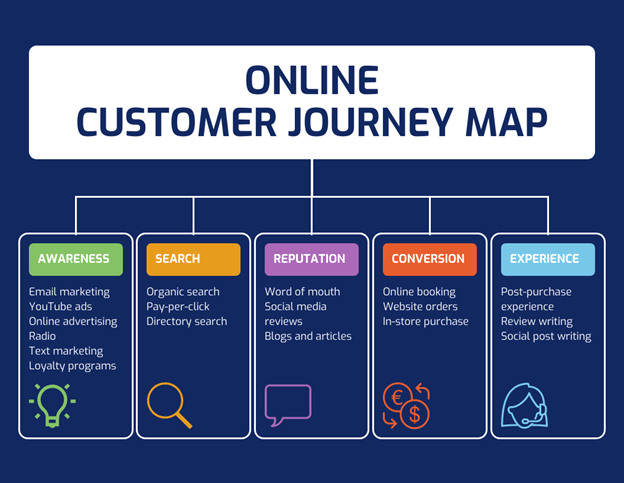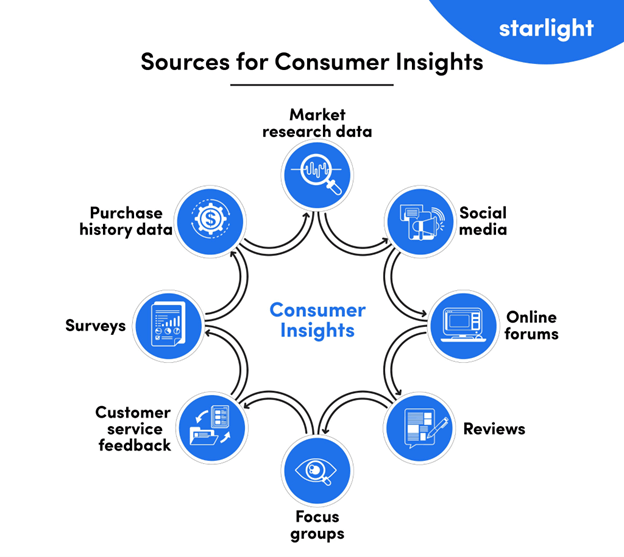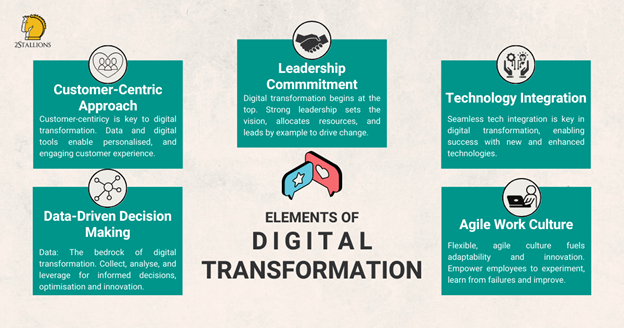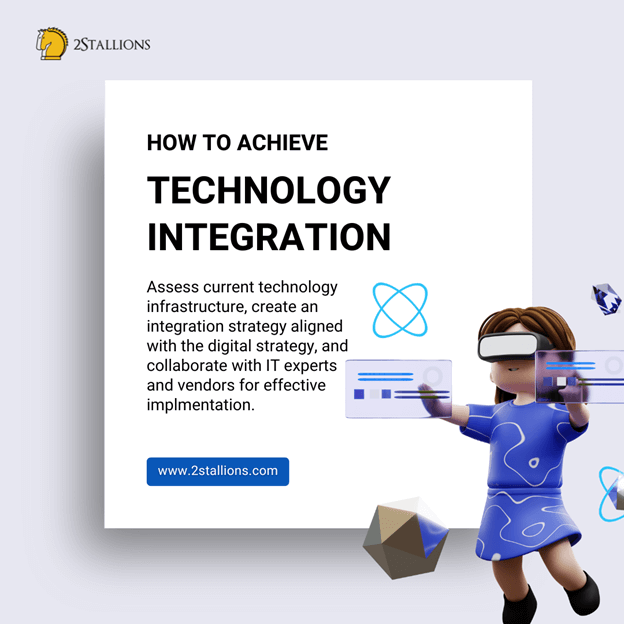Content
SHARE

The digital transformation era is here. Even if we were not ready for it yet, the events of 2020 have propelled us forward. Digital transformation refers to the complete integration of digital technologies into business. COVID-19 has pushed most companies to pivot and adopt some digital strategies and technologies to stay in touch with their customers and keep themselves above water.
Complete digital transformation takes time and patience. The pandemic has served as a wake-up call for businesses and their leaders to take steps towards fully integrating digital systems across their companies. Transforming a company can be intimidating and stressful if not planned out properly. Companies can ease into the digital transformation strategically by taking on one aspect at a time. There are four key aspects of digital transformation:
- Processes
- Business Model
- Domain
- Cultural/Organisation
Navigating the Digital Transformation Era
Business processes are often the first to undergo digitisation – preferred communication methods changing from old-fashioned memos to email is an example of a digital transformation in the last decade. Later, the adoption of VOIP tools such as Skype and, afterwards, instant messengers like WhatsApp, Line, or WeChat were other transformations that digitised business communication processes.
Company culture, organisation, and domain transformation typically occur after adapting communication processes. Tools such as project management software and community platforms like Facebook's Workplace or SproutSocial's Bamboo can assist in bringing companies together and promoting a cohesive company culture.
[thrive_leads id='8271′]
Adapting entire business models can take longer. Depending on the age and size of the business, it can take a lot of time to transform the core of any company. Business models have undergone evolution, even if they were established during the company's inception. The changes faced by the company over time will influence the functioning of companies. Digital transformation is necessary for companies to adapt and thrive in the current era, especially in light of the recent pandemic. But why should a company undergo such an evolution?
 1. Digital Customer Journeys are on the Rise
1. Digital Customer Journeys are on the Rise
In an era of rapid technological advancement, the digital customer journey has emerged as a dominant force, reshaping consumer behaviour and redefining business strategies. Even before the disruptive events 2020, the trajectory towards a digitally driven customer journey was unmistakable.
-
E-commerce Expansion:
The global e-commerce surge was already transforming how consumers shopped. Online marketplaces and e-commerce platforms were gaining prominence, making many products and brands easily accessible.
-
Empowered Consumers:
Consumers found themselves more empowered than ever before. Armed with digital tools, they could meticulously research potential purchases, compare product offerings, and exchange insights through reviews and referrals.
-
Social Media Amplification:
The rise of social media platforms further accelerated this empowerment. Consumers could now engage in personal connections, discuss brands, and share their purchasing experiences with a global audience.
-
Access Anytime, Anywhere:
Marketplaces and user-friendly e-commerce websites, including platforms like Shopify, provided unparalleled accessibility. Potential customers could take their time to explore products, gather information, and conduct comprehensive research from their digital devices.
-
End-to-End Digital Experience:
From the initial spark of interest to the final transaction, the customer's journey has radically transformed, becoming digital. Optimising customer journey satisfaction along this digital path has become paramount, as it's well-documented that loyal customers tend to spend a remarkable 67% more than their new counterparts.
-
Strategic Marketing Opportunities:
Embracing digital transformation isn't just about sales—it's also a gateway to more effective marketing tactics. Companies that leverage digital channels gain better access to their customer base, enabling them to craft targeted and personalised marketing strategies that resonate with their audience's preferences and behaviours. The surge in digital customer journeys has redefined the business landscape, and companies that understand and adapt to this transformation are well-positioned to thrive in the digital age.
 2. Increased Data and Insights
2. Increased Data and Insights
While reaching customers is vital, digital transformation goes beyond that by ushering in invaluable data and insights.
-
Real-time Data Flow:
Through digital transformation, companies open the floodgates to a continuous stream of real-time data. This data serves as the lifeblood of informed decision-making.
-
Understanding Customer Behaviour:
Businesses can track, analyse, understand, and even predict customer behaviour by leveraging analytical platforms. This deeper understanding allows for more effective strategies and tailored customer experiences.
-
Unlocking Website Analytics:
Tools like Google Analytics offer a window into audience demographics and content preferences. Companies can fine-tune their online presence based on these insights, enhancing user experience and engagement.
-
Social Media Insights:
Measurement tools extend to social media platforms, shedding light on user habits, conversations, and content preferences. Companies can harness this data to refine their social media strategies and create content that resonates with their audience.
-
Omnichannel Synergy:
As omnichannel marketing gains prominence, digital transformation provides a distinct advantage. It enables online and offline data integration, offering a comprehensive view of customer interactions across various touchpoints.
-
In-Depth Audience Understanding:
The ability to profoundly know your audience is a formidable advantage. The data and insights facilitated by digital transformation are something companies can only afford to pay attention to. They represent a powerful resource for staying ahead in today's competitive landscape.
 3. Improved Inter-Company Communication & Collaboration
3. Improved Inter-Company Communication & Collaboration
Effective internal communication and collaboration have become indispensable in the modern business landscape. The digital transformation wave has ushered in a new era of streamlined connectivity, which has proven invaluable for companies during the pandemic, allowing them to keep employees connected even during extended periods of remote work.
-
Leveraging Digital Connectivity:
Adopting digital tools has enabled seamless communication and collaboration among teams across different locations. This digital transformation has been a lifeline for businesses, ensuring that information and ideas remain uninterrupted.
-
Embracing Remote Work:
The concept of remote work has undergone a remarkable transformation in recent years. Many large and small companies have come to recognise the advantages of transitioning from traditional, physically bound office spaces to a more flexible remote workforce model. This shift represents a significant departure from the conventional 9-to-5 office routine and has been accelerated by technological advancements, changing employee expectations, and the global events of the past few years.
-
The Role of Digital Transformation:
Nevertheless, digital transformation bridges this gap. By providing robust digital connectivity, companies can nurture a cohesive and connected team, regardless of physical location. Remote work becomes more manageable and sustainable when underpinned by a well-executed digital transformation strategy. The digital transformation era empowers companies to adapt to remote work and thrive in this new environment. With the right digital tools and strategies, maintaining a strong, connected team is feasible, ensuring that your workforce remains collaborative, productive, and engaged, regardless of location.
 4. Enhanced Customer Insights
4. Enhanced Customer Insights
Understanding your customers is at the heart of successful business operations. Digital transformation amplifies an organisation's ability to gain profound insights into its customer base, enabling more strategic decision-making and customer-centric approaches:
-
Personalisation:
In the digital transformation era, personalisation is not just a buzzword; it's a fundamental strategy. With the wealth of data available through digital channels, companies can tailor products, services, and marketing campaigns to individual customer preferences. This level of personalisation fosters stronger customer relationships, increases brand loyalty, and drives sales. Customers feel valued when their unique needs and preferences are acknowledged and catered to.
-
Predictive Analytics:
Leveraging advanced data analytics, companies can go beyond reactive approaches to customer engagement. Predictive analytics enables organisations to anticipate customer needs and trends, allowing for proactive strategies. Businesses can identify patterns, forecast trends, and plan offerings by analysing historical data and real-time information. This approach positions a company as a provider of goods or services and a trusted partner in meeting customer needs.
-
Real-time Feedback
The digital landscape provides an unprecedented opportunity to receive instant customer feedback. Whether through social media, online reviews, or direct communication channels, customers continually provide insights and opinions. Digital transformation allows companies to tap into this real-time feedback and turn it into actionable data. Organisations can enhance customer satisfaction and loyalty by promptly addressing customer concerns and adjusting based on their feedback. It also demonstrates a commitment to customer-centricity that can set a company apart from its competitors.
5. Staying Ahead of the Competition
In today's fiercely competitive business landscape, keeping pace with industry trends is no longer sufficient. Instead, staying ahead of the competition has become the paramount goal for companies looking to thrive and excel. The digital transformation era offers a golden opportunity for organisations to remain relevant and leapfrog ahead. Here's an in-depth exploration of why staying ahead of the competition through digital transformation is so crucial:
-
Agility and Adaptability
One of the core benefits of digital transformation is the enhanced agility and adaptability it brings to organisations. In an environment marked by rapid technological advancements and evolving consumer preferences, swiftly responding to changes is a game-changer. Digital transformation equips companies with the tools and strategies to pivot quickly in response to market shifts, changing customer expectations, and emerging technologies. It's about embracing change as an inherent part of business and using it as a competitive advantage.
-
Seizing Opportunities
In today's fast-paced business landscape, opportunities often emerge suddenly and may be short-lived. Companies embracing digital transformation are better positioned to seize these opportunities. Whether it's a new market segment, a groundbreaking technology, or a unique partnership, digitally transformed organisations can more effectively identify and capitalise on these openings. Businesses adopting digital transformation are not merely reacting to change but actively seeking and creating opportunities to propel them ahead of competitors.
-
Attracting Top Talent
Talent acquisition and retention are pivotal to success in the modern business world. The best minds in any industry are drawn to companies that demonstrate innovation and a commitment to growth and development. A digitally transformed organisation is inherently attractive to top talent. It signals a forward-thinking approach and a willingness to invest in cutting-edge technologies and methodologies. Top talent seeks out environments where they can contribute to meaningful change, and a digitally transformed workplace provides precisely that opportunity.
 Five Key Elements of Digital Transformation
Five Key Elements of Digital Transformation
Digital transformation is a complex process that requires careful planning and execution. While there are many facets to this journey, the following five elements stand out as the most critical for achieving success:
Leadership Commitment:
Digital transformation starts at the top. Strong leadership commitment is essential for driving change throughout the organisation. Leadership should set the vision, allocate resources, and lead by example to inspire the team.
 Customer-Centric Approach:
Customer-Centric Approach:
Understanding and meeting customer needs is at the core of digital transformation. Businesses must use data and digital tools to create seamless, personalised, engaging customer experiences.
 Data-Driven Decision Making:
Data-Driven Decision Making:
Data is the foundation of digital transformation. Organisations must collect, analyse, and leverage data to make informed decisions, optimise operations, and identify new opportunities.
 Technology Integration:
Technology Integration:
Digital transformation often involves adopting new technologies or enhancing existing ones. Seamless integration of these technologies is critical to achieve the desired outcomes.
 Agile Work Culture:
Agile Work Culture:
A flexible and agile work culture fosters adaptability and innovation. Employees should be empowered to experiment, learn from failures, and continuously improve processes.

Final Thoughts
In the ever-evolving business landscape, digital transformation emerges as the next step and as the cornerstone of success. The disruptive events of the past years, including the global pandemic, have accelerated the need for companies to embrace digital tools and processes. This acceleration, though challenging, is also an opportunity—an opportunity to future-proof your organisation and thrive in an increasingly digital world.
Digital transformation isn't merely about keeping up with the times; it's about setting the pace and redefining the rules. It's about leveraging technology to create innovative solutions, enhance customer experiences, streamline operations, and gain a competitive edge. Adaptation isn't just a strategy; it's a necessity in this era. The companies that recognise this necessity and invest in it with vision and commitment are poised to lead and succeed in the rapidly changing business landscape.
As you embark on your digital transformation journey, remember that it's not just about embracing technology; it's about adopting change, fostering agility, and nurturing a culture of innovation. It's about staying ahead of the curve, delivering value to your customers, and building a resilient and future-ready organisation. In this digital transformation era, the question isn't whether to adapt; it's how boldly and effectively you will embrace the future.
Originally published: 29 October 2020
Updated: 18 October 2023
Transform Your Online Presence With Expert Internet Marketing Services Tailored for the Digital Age.Our strategic approach merges innovative techniques with proven methods to propel your business into the future. Experience a seamless digital transformation that amplifies your brand's reach and impact.
Frequently Asked Questions About Digital Transformation
What Are the 4 Areas of Digital Transformation?
The four primary areas of digital transformation are:
- Business Process: This involves reimagining processes, operations, and customer journeys by leveraging digital tools and methodologies.
- Business Model: Rethinking how the organisation creates, delivers, and captures value.
- Domain: Expanding or shifting the boundaries of an enterprise into new revenue opportunities or industries.
- Cultural/Organisational: Changing the internal company culture, skills, and structures to support the digital transformation journey.
What Is Digital Transformation and its Example?
Digital transformation refers to incorporating digital technology into all business areas, leading to fundamental changes in how businesses operate and deliver value to their customers. It's also a cultural shift requiring organisations to challenge the status quo continually. For example, a traditional taxi company incorporating an app-based booking system to compete with services like Uber represents a form of digital transformation.
What Are the Benefits of Digital Transformation?
Toggle content go
Benefits of digital transformation include:
- Enhanced Customer Experience: Offering more personalised, convenient experiences for customers.
- Operational Efficiency: Streamlining operations and reducing costs.
- Increased Agility: Faster decision-making and ability to pivot as the market changes.
- Data-Driven Decision Making: Utilising analytics and data to guide strategies.
- Improved Profitability: Accessing new revenue streams and increasing current ones.
es here, click edit button to change this text.
What Is the Most Important Aspect of Digital Transformation?
While all components of digital transformation are crucial, the most important aspect is often considered cultural/organisational change. This is because technology alone cannot drive change. It requires a mindset, attitude, and company culture shift where everyone is aligned and willing to adapt. With cultural buy-in, many digital transformation efforts can succeed.

 1. Digital Customer Journeys are on the Rise
1. Digital Customer Journeys are on the Rise 2. Increased Data and Insights
2. Increased Data and Insights 3. Improved Inter-Company Communication & Collaboration
3. Improved Inter-Company Communication & Collaboration 4. Enhanced Customer Insights
4. Enhanced Customer Insights Five Key Elements of Digital Transformation
Five Key Elements of Digital Transformation Customer-Centric Approach:
Customer-Centric Approach: Data-Driven Decision Making:
Data-Driven Decision Making: Technology Integration:
Technology Integration: Agile Work Culture:
Agile Work Culture:










